Happy New Year, Geekly Magic fans, and welcome back to Magic Gatherings! I’m back myself after a year-end hiatus and excited to get back to writing. I hope you didn’t miss me too much! (Please say you missed me. Just a little?)
It feels like I start half my articles this way, but we already have a new set on the horizon. Oath of the Gatewatch—the second set in the Battle for Zendikar block—will host its prerelease tournaments in less than two weeks, and if you’ve been on the lookout, you have surely seen some preview cards on the Wizards website and around the Internets. Today I’ll preview the new set, which will bring new mechanics, flashy new cards, and the dramatic conclusion to the Battle for Zendikar storyline. Let’s get to it!
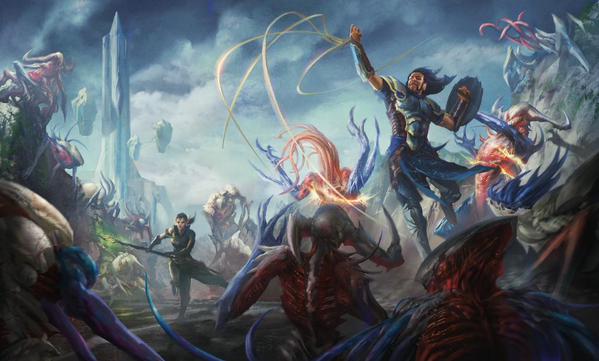
Setting the Watch
About that storyline. When we left our heroes (the rough-and-ready warrior Gideon, the mind-mage Jace Beleren, and the elven land-animator Nissa Revane), they had united a ragtag band of Zendikar natives and led this army of survivors to retake the city of Sea Gate. There they set a trap for the Eldrazi titan [mtg_card]Ulamog, the Ceaseless Hunger[/mtg_card]: they would lure it to Sea Gate and bind it in a ring of stone hedrons, artifacts that have the power to direct Zendikar’s ley lines to imprison Eldrazi.
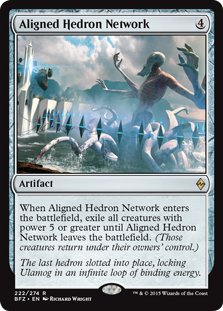
Their plan actually worked—right up until the point when Ob Nixilis, an ancient demon-planeswalker imprisoned on Zendikar for millenia, used the hedron trap to direct the ley line energy at himself and thereby reignited his planeswalker spark. Ob Nix, being the interplanar asshole he is, decided to leave Zendikar a parting gift on his way out: he called out to a second Eldrazi titan, Kozilek, which had previously been burrowing underground. He also broke Jace’s jaw (sweet) and nearly drowned Gideon in a puddle. Kozilek, for its part, prompty one-shotted a legendary octopus summoned by the merfolk planeswalker Kiora (also a Zendikar native fighting for her home plane, but not much of a team player).
So there we have it: their hedron ring is busted, their plan is ruined, and the planeswalkers now have two alien, world-devouring un-gods to contend with.
Oath of the Gatewatch will tell the story of how Gideon, Nissa, and Jace—along with the pyromancer planeswalker Chandra Nalaar, who turned up just as Ob Nixilis was fucking everything up—rally together to challeneg Ulamog and Kozilek. In the process, they form a pact (the “Gatewatch”) to protect the planes of the multiverse from threats no one else can handle: an interplanar Justice League, if you will.
If you want more Magic story, check out this summary or read the full archives in Wizards’ creative fiction column, “Uncharted Realms.”
Oath of the Gatewatch Mechanics
The set’s two major story themes—the return of the Eldrazi titan Kozilek and the teamwork of planeswalkers coming together to face an impossible challenge—guide the new mechanics that are showing up in Oath of the Gatewatch. How do you represent those ideas on cards? In Kozilek’s case, the answer is: bizarrely.
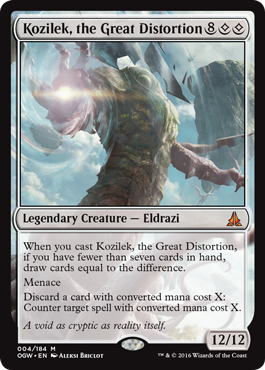
Kozilek is the titan whose presence distorts reality, and you (fittingly) might feel you can’t believe your own eyes right now. The diamond-shaped mana symbol in Kozilek’s casting cost represents colorless mana. That is to say: you summon Kozilek for ten mana total, and two of it must be colorless.
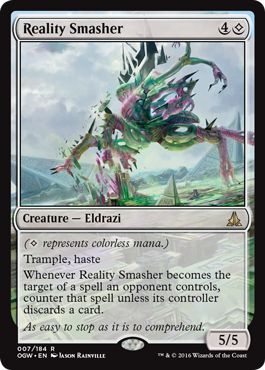
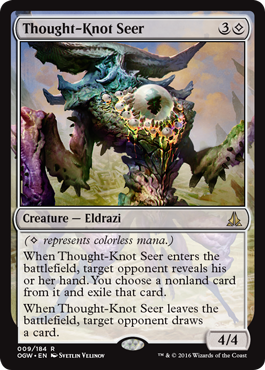
Lots of Kozilek’s brood share this as a unifying mechanical theme: true colorless creatures that require colorless mana to summon. As befits their otherworldly, reality-confounding nature, these guys have some crazy abilities—things we’ve kinda, sorta seen before, but never in quite this way. Incidentally, a number of these cards look pushed for constructed. They are powerful and exciting.
Okay, cool. But why the new symbol? Haven’t we had colorless mana forever?
Well, we have, it’s just been represented in a confusing way. Take [mtg_card]Hedron Archive[/mtg_card], a card I’ve chosen because everyone else who talks about this picks [mtg_card]Sol Ring[/mtg_card].

Hedron Archive costs four mana to cast. It can be mana of any color—Hedron Archive don’t care. It could even be colorless mana! Four mana, any mana, is all you need. The rules term for this, although no one ever uses it, is generic mana. It’s always part of a mana cost and always denotes the extra mana (of any type) you need to pay to cast a spell or activate an ability. It’s always been represented by a number within a gray circle. Take [mtg_card]Gideon, Ally of Zendikar[/mtg_card]: he costs four mana—two white, two generic (i.e., anything). Nothing crazy so far—you’ve known this since you learned how to cast spells.
But wait! There are other numbers on Hedron Archive. It can tap for mana: two colorless mana, in fact. And that colorless mana is also represented by a number in a circle—even though it’s actually not the same thing as generic mana. Check out Hedron Archive’s third ability: you pay two mana (two generic mana) and sacrifice the Archive to draw two cards. You don’t need colorless mana to activate Hedron Archive’s second ability, but the symbol in the cost (generic mana) looks exactly like the symbol in card’s mana ability (colorless mana). You can see how this could be confusing.
This system has worked so far because no card has ever stipulated that you must use colorless mana to cast it. Generic mana was always in costs, and colorless mana was always produced by a card’s abilities, and any confusion was staved off because the two never crossed up. Now that we have cards that require colorless mana, though, we need some new symbols to represent them. (Fun fact: colorless-mana-as-a-cost was first publicly floated by Jonathon Loucks in the second Great Designer Search competition, where it met with some lukewarm reception.)
Or, to crib WotC’s example, take a look at two versions of Unknown Shores, one from Theros and one from Oath:
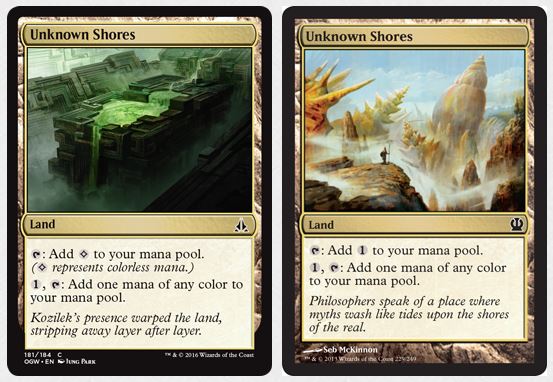
Source: Wizards.com
Unknown Shores taps for one colorless mana as its first ability, and always has. The Oath version has its spiffy new colorless mana symbol to represent that. The Theros version uses the old symbol, a {1} in a circle.
The second ability of Unknown Shores is that you can pay one “generic” mana—that is, one mana of any color at all, or even one colorless mana—and get a mana of the color of your choice. That cost has always been represented by a little number in a circle, and that will continue.
So, to sum up: if you have a little diamond, it’s colorless mana. When that diamond is in a mana cost, you must pay it with colorless mana. If it’s a little number in a circle, it’s generic mana. Generic mana always shows up in costs, and you can always pay with any kind of mana you like.
Using colorless mana in this new way—requiring it as a cost—is actually pretty close to making it a sixth “color” in its own right. You’ll need to pay careful attention to the lands you put in your deck to make sure you can cast your colorless spells. Fortunately, the Oath design team has you covered:
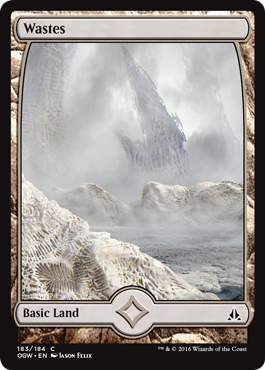
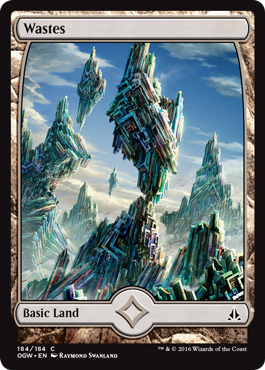 Oath is introducing new basic lands, Wastes, which generate colorless mana. Functionally, these work like Plains, Islands, Swamps, Mountains, or Forests: you can put as many in your deck as you like, and if a card would care about finding a basic land ([mtg_card]Evolving Wilds[/mtg_card], say), it can find Wastes.
Oath is introducing new basic lands, Wastes, which generate colorless mana. Functionally, these work like Plains, Islands, Swamps, Mountains, or Forests: you can put as many in your deck as you like, and if a card would care about finding a basic land ([mtg_card]Evolving Wilds[/mtg_card], say), it can find Wastes.
Flavorfully, colorless mana is being used to signify lands that the Eldrazi have consumed. The Wastes are lands that have been sucked dry; they can still produce mana, but not mana of any color. You can see this in action on Crumbling Vestige, which might be my favorite card in the set so far:
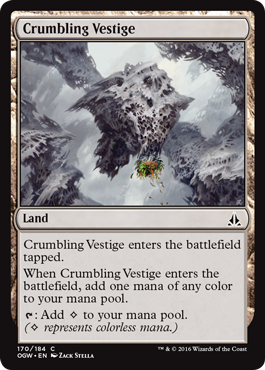
One last gasp, and then it produces colorless mana forever: this little card tells quite the story.
Taking the Oath
On the other side of the conflict, we have the defenders of Zendikar, pulling together to fight Ulamog and Kozilek. Collectively, they represent the “teamwork” theme, and there are a few mechanics that help to bring that to life.
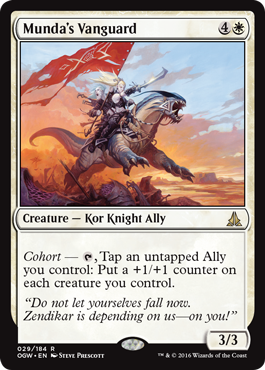
Allies are back, and they have a new trick, called cohort. Cohort describes a variety of activated abilities that only show up on Allies, and always require you to tap two creatures: the Ally that has the cohort ability, plus one other untapped Ally. The abilities seem especially geared for limited, and help Allies play a longer game. A few things to note: first, the second Ally you tap can be any Ally, whether it has its own cohort ability or not. (If both Allies have cohort abilities, you don’t get to double up; each cohort ability requires two creatures to be tapped.) The second Ally can be one you just summoned, though. So, if you untap with Munda’s Vanguard and summon a fresh [mtg_card]Kor Castigator[/mtg_card], you can still use the Vanguard’s cohort ability.
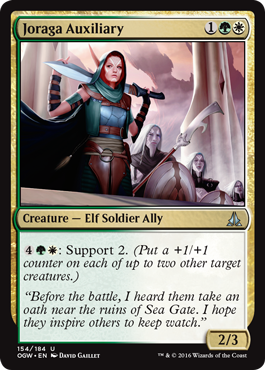
There’s also support, a nifty keyword action that can buff up your team. Every time you activate or trigger a support ability, you get to pick a number of creatures you control (so far it ranges from two to six) and put a +1/+1 counter on each one of them. It looks like an interesting limited mechanic, which could help shut the door after a strong start or keep your creatures big enough to matter in the lategame.
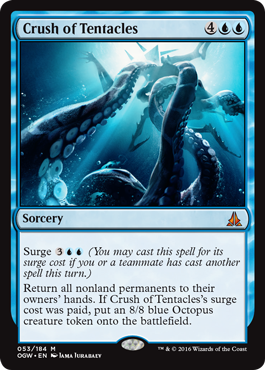
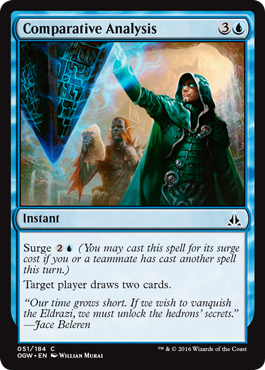 The third teamwork mechanic makes “teamwork” a little more literal: dubbed surge, it’s an alternate-cost mechanic which gives you a discount on your spells if you have already cast another spell this turn. Some surge cards, like Crush of Tentacles, have kicker-like abilities that give you a bonus when you cast them for their surge cost. The set also has a number of cards with special bonuses that trigger when you cast your second spell each turn, to encourage surging whenever possible.
The third teamwork mechanic makes “teamwork” a little more literal: dubbed surge, it’s an alternate-cost mechanic which gives you a discount on your spells if you have already cast another spell this turn. Some surge cards, like Crush of Tentacles, have kicker-like abilities that give you a bonus when you cast them for their surge cost. The set also has a number of cards with special bonuses that trigger when you cast your second spell each turn, to encourage surging whenever possible.
The interesting twist that surge brings to the table is that you can also get the surge bonus if one of your teammates has cast a spell this turn. Since Magic is a game primarily designed for duels between two players, Wizards has avoided explicit references to “teammates” and the like up until this point. But no more! So if you’re a big fan of multiplayer formats like Two-Headed Giant [PDF link there], surge will be up your alley. In fact, Wizards is making a push for prereleases to feature Two-Headed Giant Sealed deck as a possible format, so if that sounds like fun, you should be on the lookout if your local store has those events.
2HG is near and dear to my heart, as my old Magic group in Atlanta had a quarterly tradition of playing a Two-Headed Giant tournament for every expansion release. In the last tourney I was able to attend before I moved back to Boston, I brought along an oversized foam Garruk’s Axe (from the 2015 San Diego Comic Con promo package) and left it with the group as a traveling trophy for each winning team to sign their names to. (Luckily, my friend and I won that tournament, so I was able to sign it before I left. Double [mtg_card]Palace Siege[/mtg_card] is no joke.)

Pictured: the author and friend Joshua, 2HG Champions
In brief, if you’ve never had the pleasure of 2HG sealed: you and your friend get a slightly larger sealed pool, build two decks from it, and then each choose one deck to pilot. Your team takes one single turn, so you and your buddy will play spells at the same time, although you don’t share a hand, lands, or mana. When you attack, you attack the opposing team, and your opponents can decide together what to block with and how. The players on a team do share a life total (of 30 life points), so effects that deal damage to “each opponent” wind up counting double; hence our win off [mtg_card]Palace Siege[/mtg_card], which dealt 2 damage to each opponent—four damage total—during our team’s upkeep step. So play those [mtg_card]Kalastria Healer[/mtg_card]s if you open them.

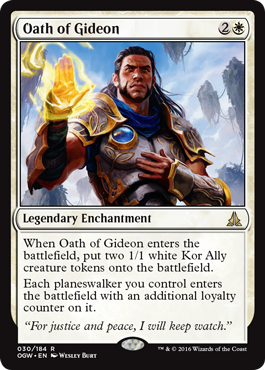 The last “teamwork” element is a bit more diffuse, but still exciting: a number of cards give you bonuses for playing planeswalkers, and especially for playing several planeswalkers at the same time. There’s an “Oath” cycle of one legendary enchantment for each member of the Gatewatch which represents the vow they take to defend the multiverse. Each one has a good enters-the-battlefield effect, plus an ongoing effect to buff planeswalkers. There’s also Call the Gatewatch, which will tutor up any planeswalker in your deck you need. Keep that Gatewatch on speed dial!
The last “teamwork” element is a bit more diffuse, but still exciting: a number of cards give you bonuses for playing planeswalkers, and especially for playing several planeswalkers at the same time. There’s an “Oath” cycle of one legendary enchantment for each member of the Gatewatch which represents the vow they take to defend the multiverse. Each one has a good enters-the-battlefield effect, plus an ongoing effect to buff planeswalkers. There’s also Call the Gatewatch, which will tutor up any planeswalker in your deck you need. Keep that Gatewatch on speed dial!
Watching the horizon
That’s all for this week, folks. Hope you enjoyed this preview—it’s good to be back! Keep an eye on the official Wizards page for more Oath of the Gatewatch previews as they are revealed, and I’ll be back next week with my limited set review for Oath—just in time for you to hit the prereleases next weekend!
